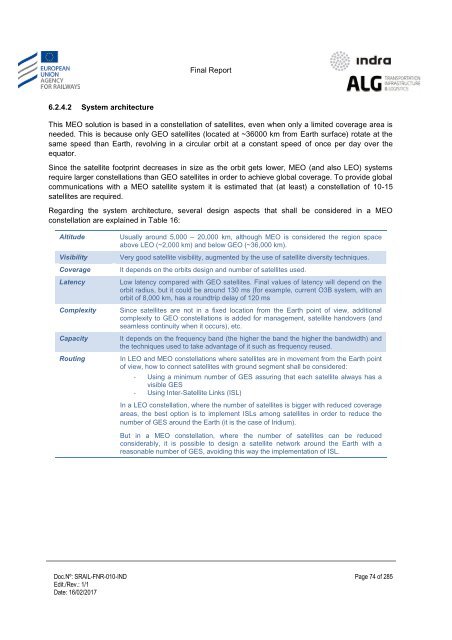Study on feasibility of SATCOM for railway communication
SRAIL-FNR-010-IND%20-%20FinalReport_v1.1_20170216
SRAIL-FNR-010-IND%20-%20FinalReport_v1.1_20170216
You also want an ePaper? Increase the reach of your titles
YUMPU automatically turns print PDFs into web optimized ePapers that Google loves.
Final Report<br />
6.2.4.2 System architecture<br />
This MEO soluti<strong>on</strong> is based in a c<strong>on</strong>stellati<strong>on</strong> <strong>of</strong> satellites, even when <strong>on</strong>ly a limited coverage area is<br />
needed. This is because <strong>on</strong>ly GEO satellites (located at ~36000 km from Earth surface) rotate at the<br />
same speed than Earth, revolving in a circular orbit at a c<strong>on</strong>stant speed <strong>of</strong> <strong>on</strong>ce per day over the<br />
equator.<br />
Since the satellite footprint decreases in size as the orbit gets lower, MEO (and also LEO) systems<br />
require larger c<strong>on</strong>stellati<strong>on</strong>s than GEO satellites in order to achieve global coverage. To provide global<br />
communicati<strong>on</strong>s with a MEO satellite system it is estimated that (at least) a c<strong>on</strong>stellati<strong>on</strong> <strong>of</strong> 10-15<br />
satellites are required.<br />
Regarding the system architecture, several design aspects that shall be c<strong>on</strong>sidered in a MEO<br />
c<strong>on</strong>stellati<strong>on</strong> are explained in Table 16:<br />
Altitude<br />
Visibility<br />
Coverage<br />
Latency<br />
Complexity<br />
Capacity<br />
Routing<br />
Usually around 5,000 – 20,000 km, although MEO is c<strong>on</strong>sidered the regi<strong>on</strong> space<br />
above LEO (~2,000 km) and below GEO (~36,000 km).<br />
Very good satellite visibility, augmented by the use <strong>of</strong> satellite diversity techniques.<br />
It depends <strong>on</strong> the orbits design and number <strong>of</strong> satellites used.<br />
Low latency compared with GEO satellites. Final values <strong>of</strong> latency will depend <strong>on</strong> the<br />
orbit radius, but it could be around 130 ms (<strong>for</strong> example, current O3B system, with an<br />
orbit <strong>of</strong> 8,000 km, has a roundtrip delay <strong>of</strong> 120 ms<br />
Since satellites are not in a fixed locati<strong>on</strong> from the Earth point <strong>of</strong> view, additi<strong>on</strong>al<br />
complexity to GEO c<strong>on</strong>stellati<strong>on</strong>s is added <strong>for</strong> management, satellite handovers (and<br />
seamless c<strong>on</strong>tinuity when it occurs), etc.<br />
It depends <strong>on</strong> the frequency band (the higher the band the higher the bandwidth) and<br />
the techniques used to take advantage <strong>of</strong> it such as frequency reused.<br />
In LEO and MEO c<strong>on</strong>stellati<strong>on</strong>s where satellites are in movement from the Earth point<br />
<strong>of</strong> view, how to c<strong>on</strong>nect satellites with ground segment shall be c<strong>on</strong>sidered:<br />
- Using a minimum number <strong>of</strong> GES assuring that each satellite always has a<br />
visible GES<br />
- Using Inter-Satellite Links (ISL)<br />
In a LEO c<strong>on</strong>stellati<strong>on</strong>, where the number <strong>of</strong> satellites is bigger with reduced coverage<br />
areas, the best opti<strong>on</strong> is to implement ISLs am<strong>on</strong>g satellites in order to reduce the<br />
number <strong>of</strong> GES around the Earth (it is the case <strong>of</strong> Iridium).<br />
But in a MEO c<strong>on</strong>stellati<strong>on</strong>, where the number <strong>of</strong> satellites can be reduced<br />
c<strong>on</strong>siderably, it is possible to design a satellite network around the Earth with a<br />
reas<strong>on</strong>able number <strong>of</strong> GES, avoiding this way the implementati<strong>on</strong> <strong>of</strong> ISL.<br />
Doc.Nº: SRAIL-FNR-010-IND<br />
Edit./Rev.: 1/1<br />
Date: 16/02/2017<br />
Page 74 <strong>of</strong> 285


